Episode 143: STS-71 - Reunion (First Shuttle-Mir Docking)
Table of Contents
Twenty years after the Apollo-Soyuz Test Project, four years after the collapse of the Soviet Union, and around a hundred days after the launch of Norm Thagard, it’s time to finally see a space shuttle dock with Mir.
Episode Audio #
Photos #
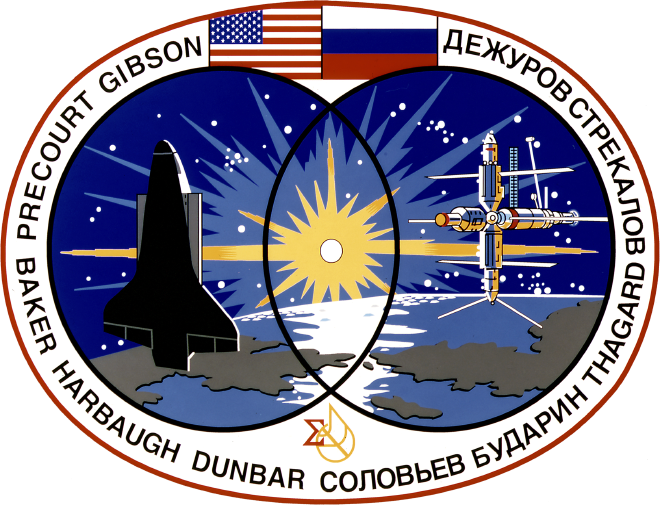
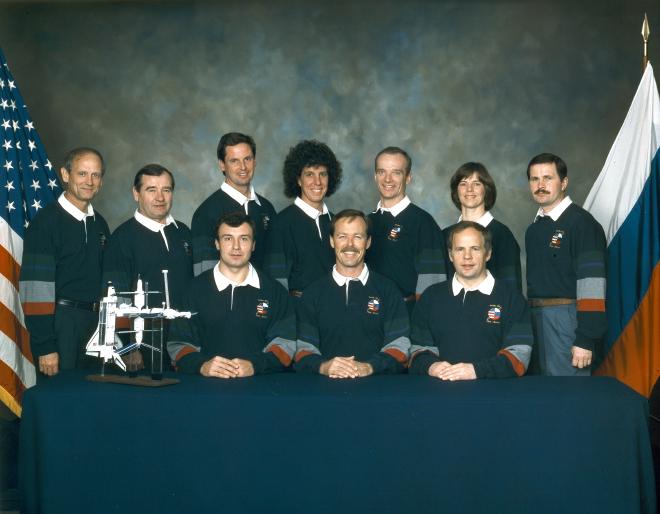
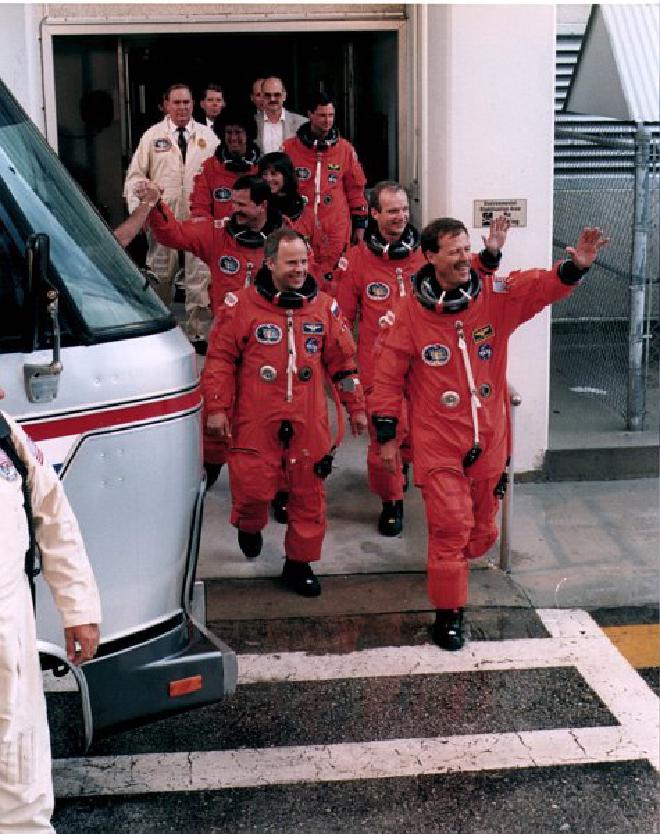
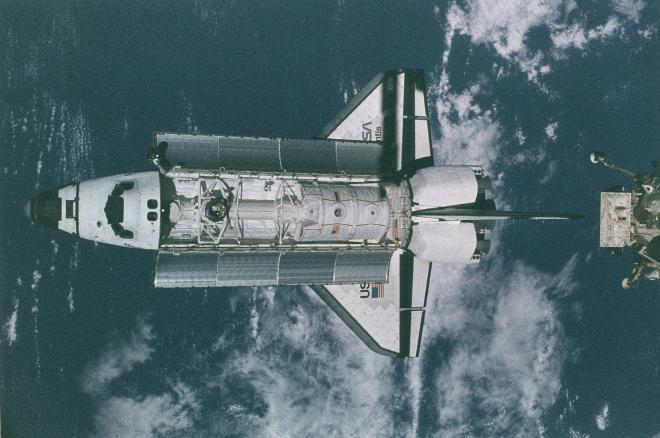
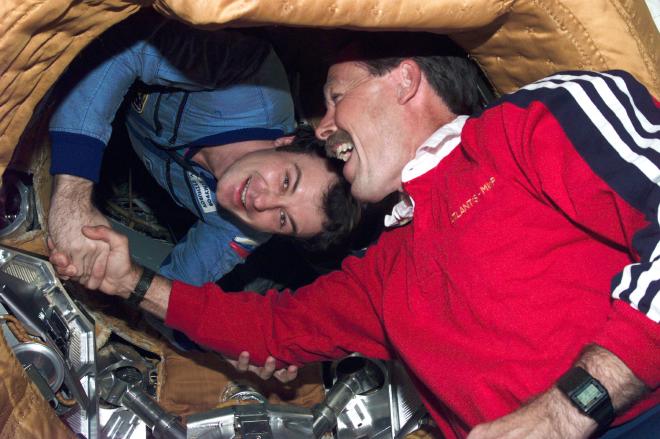
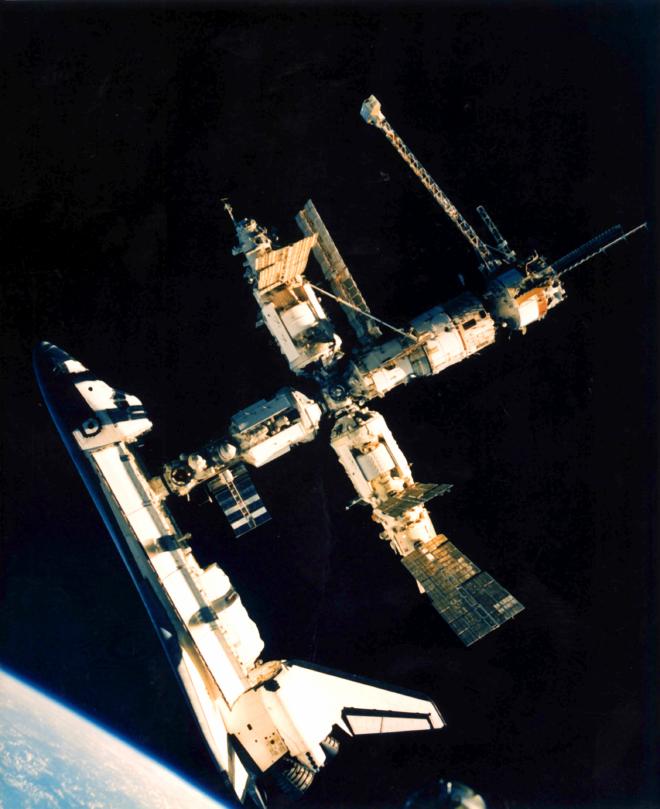
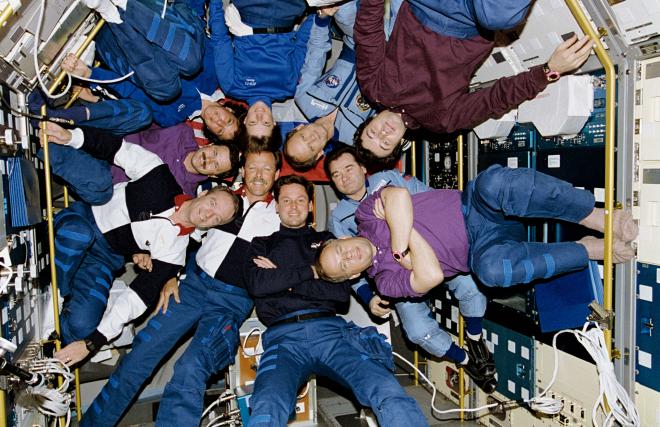
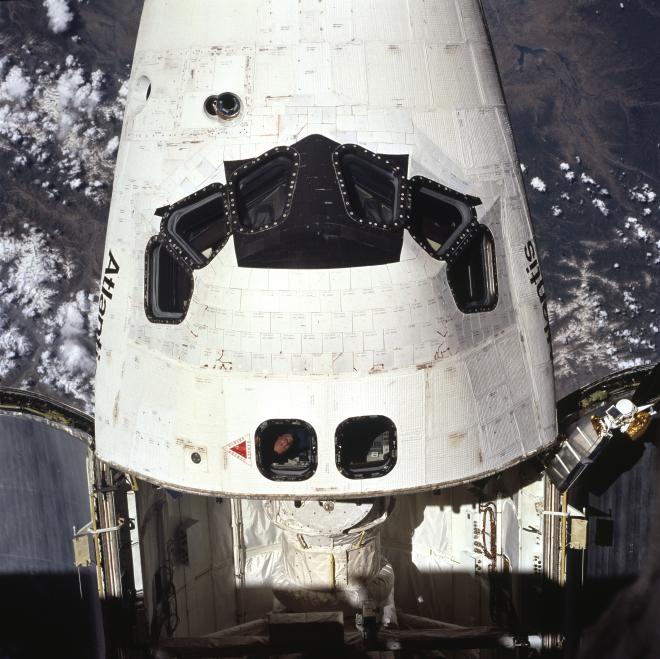
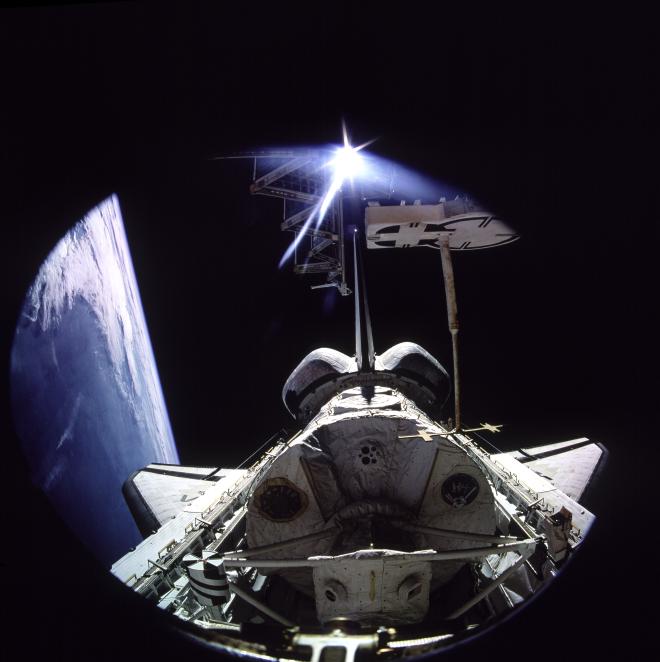
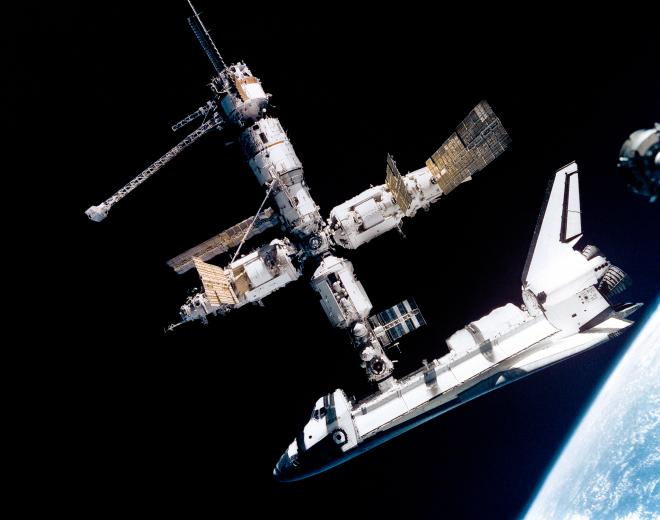
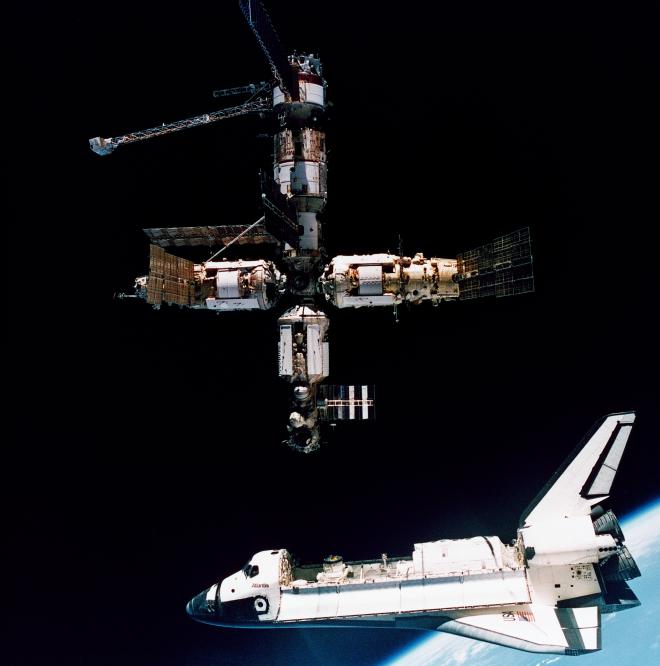
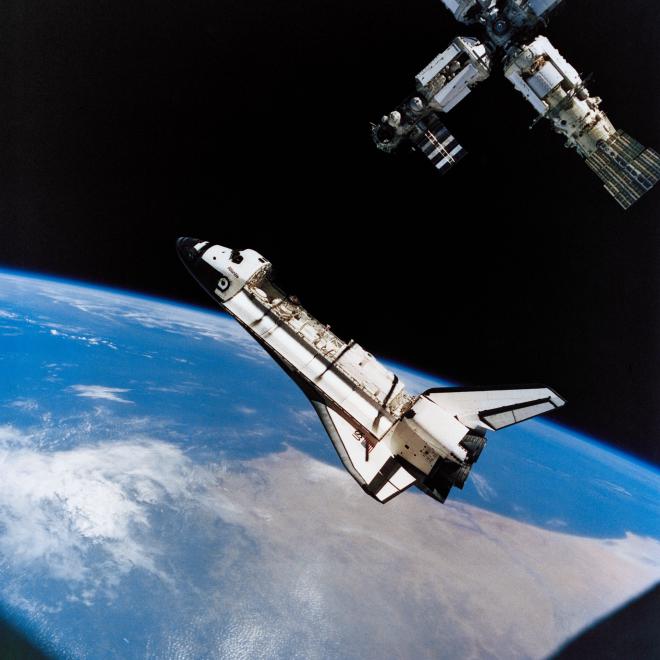
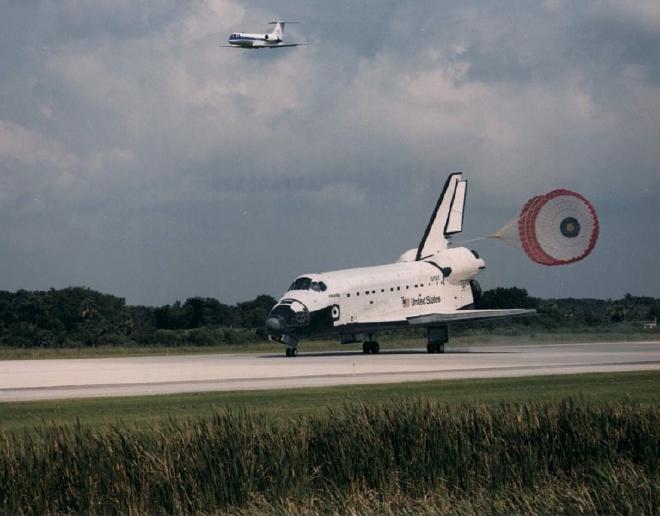
For more photos, head over to our friends at Wikiarchives.space: https://wikiarchives.space/index.php?/category/864
Post-Flight Presentation #
If you’d like to see the mission in motion you can check out the post-flight presentation here:
Mission Highlights Resource Tape #
Ever wanted to watch an hour of B-roll from STS-71? Well now’s your chance!
Transcript #
NOTE: This transcript was made by me just copying and pasting the script that I read to make the podcast. I often tweak the phrasing on the fly and then forget to update the script, so this is not guaranteed to align perfectly with the episode audio, but it should be pretty close. Also, since these are really only intended to be read by myself, I might use some funky punctuation to help remind myself how I want a sentence to flow, so don’t look to these as a grammar reference. If you notice any egregious transcription errors or notes to myself that I neglected to remove, feel free to let me know and I’ll fix it.
Hello, and welcome to The Space Above Us. Episode 143. Space Shuttle flight 69, STS-71: Reunion
Last time, we talked about the second and final flight of the ASTRO payload. This groundbreaking package of instruments provided astronomers with a whole new tool for studying the cosmos: ultraviolet light. Today, we’ll be focusing less on the cosmos, and more on cosmonauts.
That’s because today we’ll be talking about STS-71, the first Space Shuttle flight to dock with the Russian space station Mir. On the one hand, it feels like this flight has been a long time coming. I first mentioned it way back on episode 95, During the Downtime, where we took a look at the spaceflight landscape during the long hiatus in shuttle flights following the loss of Challenger. But on the other hand, it feels like it just sort of sprang up out of nowhere, being first seriously discussed less than three years ago. If there’s one thing we’ve learned after following the long road to flight of, by my count, seven different types of crewed spacecraft, along with a long list of satellites and payloads, it’s that it takes a long time to make things happen in space. But as we’ve also learned.. that timeline can be shortened considerably when the higher-ups decide it’s worthwhile.
When the Soviet Union collapsed in 1991, it marked the end of a decades-long struggle between two super-powers that held the entire planet’s population hostage using an arsenal of nuclear weapons. This.. was a good thing. But in the real world, nothing is easy. In the real world, the people and territory that made up the Soviet Union were still there, in the form of Russia and a number of other countries. But now they were gripped by an economic crisis, and a complete upending of a way of life that perhaps wasn’t ideal, but was at least familiar. Funding for the Russian space program plunged even further, and suddenly, prestigious aerospace engineers found their work set on the back burner as they faced an uncertain future. If the program couldn’t be set back on the rails, these talented people might offer their unique skills in any number of other countries that the United States would prefer did not have the ability to launch massive payloads anywhere on Earth.
So just like the Apollo program, the US government was presented with an undesirable political situation along a plausible space-based solution that was, in fact, a good idea all on its own, but also just so happened to help solve the problem at hand. That’s a recipe for getting things done fast.
That solution was the International Space Station, with Shuttle-Mir representing the first phase of that program. As we’ve seen, NASA has been eager to build a permanent space station for decades. In fact, that was originally the whole reason for building the space shuttle. It was supposed to shuttle supplies and crew to a station. But space stations are complex and expensive, and despite the often forgotten contributions of Skylab, NASA didn’t really have much experience with long duration missions. By pooling their resources, the US and Russia would be creating a win-win situation. For the price of 400 million dollars, which in space terms ain’t bad, the US would be gaining priceless insight into how long duration space stations are really run, insight that Russia had earned the hard way over decades. Russia would be gaining a desperately needed injection of cash, along with the impressive lifting capabilities of the Space Shuttle Orbiter. And both would be gaining a valuable partner, bringing years of complementary experience to the table.
Plus, even if you didn’t care at all about spaceflight, what was it worth to keep Russian engineers and technicians working on building nice friendly space stations? I’m guessing a lot.
The International Space Station would be rolled out in three phases. Starting at the end, Phase 3 was the actual operation of the space station, using it as an orbiting outpost for science. Phase 2 was the construction of the ISS, which was apparently expected to wrap up around 2002, which uh.. we’ll see how that goes. But first was Phase 1: Shuttle-Mir. The idea here was for both space programs to get to know each other, to build trust, to figure out how this process was actually gonna work day to day, and to get in some practice engineering compatible hardware.
The beauty of Phase 1 was that the hardware mostly already existed. Mir has been flying since 1986, and the space shuttle already had dozens of successful flights. Not only that, everyone had a head start thanks to a little thing called the Apollo-Soyuz Test Project. We’ll talk about some of the tweaks later, but the docking mechanism used for Shuttle-Mir was largely based on the Androgynous Peripheral Docking System flown for ASTP.
So while I’m sure there were endless compatibility checks on each others’ hardware, not too much had to be built from scratch. Cosmonauts got to work learning the shuttle systems and speaking English, and astronauts got to work learning the Soyuz and Mir systems and speaking Russian. Houston and Moscow got to work developing and testing procedures. And step by step, the vision came to fruition.
When we last talked about Shuttle-Mir, it was on STS-63, which carefully approached to within only 12 meters of the Russian space station. The mission proved that the procedures worked, and that the two space agencies could handle a crisis, even if it was a relatively minor one. During the previous flight, STS-67, NASA astronaut Norm Thagard became the first American to launch into orbit inside a Soyuz, before successfully docking with Mir to begin the first American stint on the station.
Today, we’re gonna go get him.
Commanding this highly desirable flight is someone who has been weaving his way in and out of our story for over ten years: Hoot Gibson. Gibson has had a remarkable spaceflight career, with some pretty significant contributions to spaceflight history. On his first flight he snapped a picture of a free-flying Bruce McCandless that will find itself on any list of all time great photos. And on this, his fifth and final flight, Hoot will execute the first American and Russian docking in 20 years. While he moved on from the Astronaut corps, Gibson clearly hadn’t had enough of flying, since he actually went on to become a captain for Southwest Airlines. So if you were very lucky in the late 1990s and early 2000s, you may have been flown around by a real deal space shuttle commander.
Joining Gibson up front and flying as today’s pilot is Charles Precourt. When we last saw Precourt he was actually sitting a little further back on the flight deck, since he was a mission specialist on STS-55, the German-funded Spacelab D-2 mission. I’m betting he had his eye on the pilot seat all along, however, since he was serving as the flight engineer on that mission. Well, welcome to the front row, Charles. This is his second of four flights.
Moving back to the Mission Specialists, we find Mission Specialist 1, Ellen Baker. We’ve known Baker for a while now, first meeting her on STS-34, which sent the Galileo spacecraft off on its long journey, and most recently on STS-50, the US Microgravity Lab. With this mission we mark her third and final flight.
Taking Charles Precourt’s old job was Mission Specialist 2, and today’s flight engineer, Greg Harbaugh. Harbaugh last flew in space on STS-54, which deployed the TDRS-F communications satellite, but we’ve actually seen him more recently than that. When Story Musgrave entered the thermalvac chamber to test some tools for the first Hubble servicing mission, he apparently decided to ignore the pain and numbness in his fingers caused by the frigid temperatures. Musgrave experienced such severe frostbite in his fingers that Harbaugh was nearly swapped for Musgrave. Instead, Musgrave saw a frostbite specialist, and Greg Harbaugh had to wait a few years for his next mission, but it’s a pretty spiffy one so I don’t think he’s complaining. This is his third of four flights.
Mission Specialist 3, and today’s payload commander, was yet another friendly face: Bonnie Dunbar. When we last saw Dunbar, she was flying alongside Ellen Baker on STS-50, performing experiments in the US Microgravity Laboratory. Dunbar had actually been training alongside Norm Thagard in Star City, Russia for a long duration stint on Mir, so her Russian language skills would come in handy on this flight. I’m not sure where in the timeline this happened, but Russia ultimately decided that Dunbar was too short for their systems, so was cut from the long duration Mir flight. But at least she gets to visit. And it won’t be her last visit to Mir! This is her fourth of five spaceflights and I think you can now guess what her final mission will be doing.
Atlantis would also be carrying two Russians on this flight, Mission Specialists 4 and 5, Anatoly Solovyev and Nikolai Budarin. This may change in the future, but I think for now my plan is to not to give a full mini-biography for folks who are just catching a ride to Mir. Nothing against Solovyev and Budarin, I just think it’ll help streamline the crew portion of the episode a bit. That said, I will mention that while this is the fourth of five flights for Solovyev, Budarin is flying for the first time. I thought that was pretty interesting because for now at least, he’s the only Cosmonaut who’s flown on the shuttle, and not on Soyuz!
Anyway, as I mentioned, these guys make up the EO-19 Mir crew and will be replacing the crew that we’re flying home. More on that later.
STS-71 took a couple of tries to get off the pad. On the first attempt, the launch was scrubbed before propellant loading even began, thanks to a high potential for lightning in the area. Bummer, but it’s not like the crew spent hours sitting on their parachutes and oxygen bottles only to have it called off. On the second attempt, the weather still looked pretty unlikely to cooperate, with an 80% chance of unfavorable conditions. But you never know, sometimes it clears after all. The crew suited up, made the trek to the launchpad, crawled into the orbiter, strapped into their seats.. and sat there until T-9 minutes when the attempt was scrubbed due to bad weather. Turns out, sometimes you do know.
No matter though, after a couple of days of rest for the launch controllers, everyone got ready to do it again, and this time the weather would cooperate. Incidentally, if you’ve ever seen those launch platforms where the rocket is dropped from an airplane before igniting and wondered why they would go to all that trouble, this is why. If you have a stationary launchpad you have no choice but to hope that the weather conditions are within the performance capabilities of your launch vehicle. If you have an airplane, you can just fly somewhere else. But that’s unrelated, let’s get back to this launch. On June 27th, 1995, Gibson, Precourt, Harbaugh, Baker, Dunbar, Solovyev and Budarin made the trip once again to Launchpad-39A and climbed aboard Space Shuttle Atlantis. Several sources note that this is the 100th NASA human spaceflight, which seems to leave out the X-15 flights and Apollo 1, but does include Challenger. I guess we can safely call it the 100th NASA human spaceflight to launch out of Florida, but that’s getting pretty nitpicky. Regardless of what number flight it was, at 3:32 PM Eastern Daylight Time, Space Shuttle Atlantis rose from the launchpad and STS-71 was underway.
The ascent was mostly uneventful, but left us with a stern reminder that one can never become complacent when dealing with space systems. After recovery and inspection, it was determined that one of the solid rocket motors had experienced a small amount of heating effects and erosion on the primary O-ring in the nozzle assembly. The erosion was only 5 thousandths of an inch, an order of magnitude less than what was seen in the early shuttle program, but still, it’s not something you want to see.
Something we do want to see is that 8 minutes and 30 seconds after lifting off, Atlantis had made it to orbit. After coasting halfway around the world and firing up the OMS engines, it was in a 295 by 158 kilometer high orbit, inclined 51.6 degrees to the Earth’s equator, just like Mir. That unusually low perigee of only 158 kilometers (actually the lowest for the entire shuttle program) was to assist with phasing, or catching up with Mir. The smaller the orbit when compared to Mir, the faster Atlantis would catch up. And with Mir 10,000 kilometers ahead in its orbit, there was a fair amount of catching up to do. A few hours later, however, the orbit was raised to a more reasonable 390 by 295 kilometers. Don’t want to catch up too fast I guess.
For the next two days, the crew were consumed by three tasks: activating the Spacelab payload riding in the payload bay, ensuring that Atlantis was on course to intercept Mir on flight day 3, and making sure that everything was ready to go when the time came. And it’s a good thing they did. At some point on the flight somebody checked the handheld laser rangefinder that would be used to provide valuable supplemental data during the final approach to Mir, only to discover that it wasn’t powering on. Upon further inspection, the reason it wasn’t powering on became clear: there were no batteries inside! With a little effort, the lidar was soon hooked up to the orbiter power supply, so the problem was solved, but where did the batteries go? A later investigation turned up a surprisingly simple answer: the person who normally puts the batteries in the lidar was out sick and nobody else did it. Oops.
On flight day 3, the crew were awakened by mission control radioing up the Nancy Griffith song “From a Distance”, which was appropriate, because at this point Mir itself was visible.. from a distance. Just a bright point in the sky, but one that would soon be growing larger and larger as Atlantis approached.
As is typical for a rendezvous approach, from Mir’s point of view, Atlantis sort of bobbed up and down while growing ever-closer. At a distance of about 76 kilometers behind the station, Atlantis executed a brief burn to trim its approach rate and began sinking back down again. When it popped back up one revolution later, Atlantis was only about 15 kilometers back, and it was time to perform the Terminal Phase Initiation burn, which would bring the orbiter in for the final approach. This burn was carefully calculated such that when Atlantis next bobbed up to Mir’s level, it would do so directly underneath the station. This is the R-bar approach that we’ve discussed in previous episodes, with the R-bar being an imaginary line from the center of Mir to the center of the Earth. The R stands for Radius.
I know I’ve gone over how rendezvous works a few times on this show, but it’s an audio only show so it can be a little tricky, especially with it being so abstract. So let’s try comparing it to something a little more concrete and down to earth. Let’s say that you’re standing on a balcony a few stories up, perhaps enjoying a nice spaceflight history podcast, when oops, you dropped your toy space shuttle model off the balcony down to the grass below. Bummer! No problem though, because your neighbor is walking by and offers to toss the model back up to you. After a couple of attempts, your neighbor dials in the right amount of throwing force, so that the apex of the model shuttle’s trajectory is right below your face as you look down at the ground. The shuttle rises quickly at first, but it loses speed, until right below you, it runs out and for just a moment is completely stationary.. before falling back down. That’s more or less what we’re going to do here. By executing a precise series of thruster burns, Atlantis will rise up under Mir, slowing to a halt and starting to drop back down all on its own just a few hundred meters below the station, thanks to the nature of its trajectory. This is nice because no propellant is needed to slow the orbiter down, which also spares Mir from being blasted by thrusters, and if the rendezvous needs to be called off due to a problem, the crew doesn’t have to do anything. They pop up, fall back down, and get ready to try again.
OK, so let’s go back to our Terminal Phase Initiation burn. Atlantis did this about 15 kilometers back, before it dropped back down for the approach. For the next 90 minutes there were several opportunities for small correction burns to ensure that the orbiter stayed precisely in the same orbital plane as Mir, and to control the timing of the approach. When Atlantis was around 800 meters below Mir, it first crossed the R-bar. Due to the nature of orbital relative motion, we’re going to cross once, continuing to go forward a little bit while closing the distance to Mir, and then will drift back to the R-bar. That second R-bar crossing happened at around 250 meters, and from here on out, Atlantis would be under the manual control of Commander Hoot Gibson.
Gibson would perform this task from the aft of the flight deck, where there was a rotational and translational hand controller for the orbiter. Rather than looking back into the payload bay, Gibson would be looking up through the overhead windows at Mir, and more critically, at some helpful video displays. One display would show the current status of the two vehicles including the distance between them, how fast that distance was changing, where Atlantis would go next, stuff like that. Another display showed a view from the center of the docking adapter in Atlantis’ payload bay. Gibson’s job was to ensure that the center of that display lined up with the center of the docking port located on the Kristall module of Mir.
But Gibson wasn’t the only one in the hot seat. This was a full team effort. Among other tasks, Greg Harbaugh operated the laser rangefinder, and Bonnie Dunbar sat in the pilot’s seat, consulting with the timeline and using the SAREX ham radio to communicate with Mir over VHF.
As you may have suspected, my “throwing the model” analogy may paint a useful mental picture, but is a little over-simplified. That’s because unlike the model, Atlantis had multiple opportunities to pause its approach and stationkeep with Mir. These pauses gave crews and mission controllers a chance to stop and make sure everything was working as expected, while also ensuring everything stayed on a strict timeline. The timeline was important because Russia didn’t have a system like TDRSS, and could only communicate with Mir when it was over Russian ground stations, so the final docking had to take place over Russia.
At last though, the final checks had been performed and approvals granted, and CAPCOM David Wolf informed the crew that they were go to close the final gap. Commander Gibson approached at an agonizingly slow, but safe, rate of about three centimeters per second. I racked my brain for a while trying to think of something to compare that to, before giving up and declaring it to be “very slow". But when you’re about to create the largest combined spacecraft in history, it’s best to take it easy.
And Gibson’s precision paid off. The docking adapter could handle a little bit of error, but could support a closing rate of no faster than 6 centimeters per second, no more than 20 centimeters from the center, and no more than 5 degrees off. When the two docking rings touched, Atlantis was traveling at 3 centimeters per second, less than 2 centimeters from the center, within half a degree of the goal. Not bad for two massive vehicles flying at nearly 8 kilometers per second.
While a cheer erupted in Mission Control, in an oral history Dunbar said that on board, it wasn’t like a movie. The crew noted the contact and immediately moved to the next item in the checklist. Docking isn’t a moment, it’s a process. To assist with establishing a firm connection, once contact was achieved, a pre-programmed series of thruster firings was triggered, pushing the orbiter into Mir. This was especially helpful since the docking adapter wasn’t lined up with the orbiter’s center of mass, giving it less effective mass to push with, and causing a tendency to pivot, with the tail rising quote-unquote “up” towards Mir. Thrusters both pushed the overall center of mass up into Mir while keeping the tail down. Within two minutes, systems in the two docking adapters had damped out all motion, and within an hour, structural hooks had been moved into place, creating a stable connection between the two vehicles. Atlantis and Mir were hard-docked.
As I mentioned earlier, the docking mechanism would look pretty familiar, since it was largely derived from the system used on the Apollo-Soyuz Test Project, but with a few changes. For one thing, the guide petals, which helped with rough alignment, pointed inwards now instead of outwards. The overall diameter of the structure was narrower, only a meter and a half across, down from two meters on ASTP, while still leaving the pressurized tunnel inside at the same diameter. There were also 12 structural latches on this docking adapter, as opposed to only 8 on ASTP, I’m guessing since the masses involved were larger and because the docking port would be reused multiple times. These latches (or hooks, I’ve seen them called both) would rotate into place to engage with stationary elements on the other spacecraft’s side, and ensured a solid connection.
Once that connection was established, the crew rushed down to the docking port to set up cameras and microphones since this was, after all, a historic event, as well as begin to equalize the pressure between two spacecraft. Even a difference in air pressure of only 0.1 PSI could swing a hatch open at dangerous speeds. But finally, after years in the making, the hatch was opened, and Mir Commander Dezhurov and Atlantis Commander Gibson exchanged an upside down handshake in the pressurized tunnel. Dunbar said that when the hatch opened, it smelled like a well-used Russian kitchen, along with some mildew.
While it was an exciting moment, first on the agenda was actually quick safety briefing on Mir. But with that out of the way, the crew of Atlantis clamored across the tunnel for a tour of Mir. Notably, this is the first time that the orbiter has ever been completely unoccupied while in space. Among this group was NASA Astronaut/Cosmonaut Norm Thagard, who had been on Mir for the last few months. While he became good friends with his Russian crewmates, I’m sure he appreciated the visit from so many fellow Americans.
Eventually both crews gathered in Spacelab, with big American and Russian flags on the wall, and exchanged gifts. For Russia, chocolate, oranges, grapefruits, and flowers. For America, a traditional gift of bread and salt.
All ten crew members signed a ceremonial document that stated, quote “The success of this endeavor demonstrates the desire of these two nations to work cooperatively to achieve the goal of providing tangible scientific and technical rewards that will have far-reaching effects to all people of the planet Earth.” end-quote
Slightly less formally, the shuttle crew soon adorned the wall of the Mir base block with a sticker depicting their mission patch.. and then signed it.
But not everything was hugs and handshakes, bread and chocolate, proclamations and stickers. There was a lot of work to do! In fact, right after docking, the two Russians who had launched on the shuttle immediately got to work assuming control over Mir for their own lengthy mission, EO-19. The EO-18 crew switched to Atlantis as their home base, even while they were still docked.
And in addition to people, there was also a whole bunch of stuff to transfer. The top priority was to transfer two Soyuz seat liners from the shuttle to Mir. These seat liners are similar to those used by race-car drivers and are specifically molded to fit one person. With the Soyuz touchdown being compared to a mild car accident, it was important that the crew be properly supported.
Following the liners were some long term science experiments, including our old favorite, a protein crystal growth experiment. This was actually pretty clever. To keep things simple, the samples were transported in a dewar containing liquid nitrogen. The nitrogen was allowed to slowly boil off, adding to the ambient atmosphere onboard. Once enough nitrogen was gone, the samples would warm up and could begin to grow. This particular crystal growth experiment would remain onboard until the next shuttle mission, scheduled for later that year. In order to help assess the results, the crew also transferred an accelerometer which had flown on the shuttle numerous times. This way when scientists inspected the crystals they’d have an idea of what sort of forces they had been subjected to.
The shuttle crew would also be taking advantage of its large amount of fuel cell reactants, and that most useful of byproducts, water, in order to help out their Russian friends. During their stay, Atlantis topped off the Mir atmosphere with 22 kilograms of oxygen and 40 kilograms of nitrogen, helping to replenish the inevitable tiny leaks that any spacecraft experiences. On top of that, the crew also transferred nearly 500 kilograms of water, saving valuable mass and volume on future Progress resupply vehicles.
And the flow of items went from Mir to Atlantis as well. In addition to the EO-18 crew, Atlantis also too took on some air and surface samples, so the ground could learn more about conditions on Mir, and some science experiments, including a bunch of quail eggs that had been fixed at various stages of embryo development. Somewhat hilariously, at least to me, they also accepted a bunch of, well, basically trash. Just a bunch of bulky foam from the newly added Spektr module. Space was at a premium both in Mir and on the Progress resupply ships and Soyuz descent stage. So taking advantage of the giant orbiter was a big help. Apparently some additional space was made by giving the Mir crew some extra food, including some tortillas.
During the time the two vehicles were connected, there were no major technical problems. Perhaps the biggest was the fact that the forward RCS module was using 70% more propellant than expected. This is because while they were mated, the orbiter assumed the job of maintaining attitude control. I’m not sure why it was Atlantis and not Mir, but it was important to choose just one. You don’t want control systems fighting each other. Atlantis was maintaining Mir in an inertially fixed attitude, but burning through way more propellant than expected. The two downward-facing vernier engines in the back of the orbiter, L5D and R5D, slightly impinged on the body of the orbiter itself. That is, it was hitting the elevons and body flap with a bit of the thruster plume. The impingement problem was well known, but had never been a problem before they had flown to Mir and had to deal with a really unusual center of mass. For now, they switched to a gravity gradient stabilized attitude, and for later, a software patch would correct the problem.
After five days, it was time to say goodbye. There was another round of gift giving, including a sort of weird amount of custom wristwatches. Hoot Gibson also presented Anatoly Solovyev, the EO-19 commander, with a jersey from the Houston basketball team The Rockets. A delighted Solovyev immediately put it on and executed a zero-g jump shot.
With a final handshake, the two hatches were once again sealed, and the tunnel was depressurized. The Shuttle and Mir would soon once more be separate spacecraft, but Russia had a spectacular conclusion to the encounter planned. As the Atlantis crew made final preparations to leave, the EO-19 crew got aboard their Soyuz spacecraft and undocked, flying slightly out of Mir’s orbital plane. Their goal was to take photos and video of Atlantis as it undocked, and oh man, did they succeed. When Atlantis released, it was pushed back by springs in the docking mechanism, and once free, Gibson blipped the thrusters for a quick low-Z burn to accelerate the drift away from the station. Throughout it all, the EO-19 crew snapped incredible photo after incredible photo. If you’re listening to these episodes as they come out, head to the show’s twitter feed, twitter.com/SpaceAboveUs, or if you’re listening later and I finally got the show notes page up, just head to thespaceabove.us. Or failing all that, just go to your image search engine of choice and search for “STS-71” and prepare to catch your jaw as it drops.
This was only the second time that three crewed spacecraft had operated in such close proximity. And come to think of it, just off the top of my head, I’m not sure it’s ever happened again, but don’t hold me to that. And while no photo from space is boring, typically when you see images of spacecraft it’s either from right on top of it during an EVA, or with some axis directly facing the camera as it approaches on a rendezvous. With Soyuz out of plane, we got some artistic angles that look straight out of Hollywood, it’s amazing.
Once it had backed away, Atlantis once again fired its thrusters and began a slow fly-around maneuver, tracing out a circle about 135 meters away from Mir over the course of an hour and a half. This allowed them to inspect Mir in order to help with future flights.
At this point, the question of “hey, why don’t they take cool photos like this all the time” was answered. With the Mir crew puttering around in their Soyuz, the space station computer crashed, leaving the station in free-drift mode, rotating at about 0.2 degrees per second. The crash was caused by a software glitch, with a program writing to a piece of computer memory that it shouldn’t have. But software problems have a way of becoming hardware problems pretty quickly in space. The Soyuz crew cut their fly around short by a few minutes and hurried in to successfully re-dock. Ah well.
As Atlantis soared off into the orbital sunset, there were still a few days left in the mission. Remember how I mentioned Spacelab being in the payload bay? Because Spacelab is totally back there. In fact, just like a station wagon, Spacelab was in the way back, making up for the unusual center of mass caused by the addition of the docking equipment. In addition to its further-aft placement, Spacelab also had three racks of equipment removed to reduce mass and make room for other stuff. Also, the new placement necessitated an extra long tunnel to the middeck. I wonder if the crew were able to fly down the extra-long tunnel without touching the sides.
Much of the Spacelab gear was dedicated to studying the EO-18 crew, including Norm Thagard. With his 115 day spaceflight, Thagard had easily broken the American record of 82 days set by the Skylab 4 crew. And scientists were eager to have their own long duration test subject to poke and prod. So Thagard and his Russian crewmates underwent various tests studying their blood, metabolism, cardiovascular system.. you know, the classics. They even tried a bizarre collar-like device that tried to prompt a response from the body by squeezing and releasing the carotid artery. Sounds delightful. The trio also put in two hours of vigorous exercise every day for a week before landing in an attempt to counteract the effects of their long duration flight. So Spacelab was a pretty busy place for the back half of the mission.
But after a couple of days it was time to prepare to come home. For the long haul spacer-farers, special recumbent seats had been prepared on the middeck, rather than the regular chairs, which crews just sat in in a typical seated position. By returning to earth on their backs, with the legs elevated a bit, it was hoped that they could have a more pleasant journey home, one that didn’t stress their out-of-practice cardiovascular system. For once, the weather in Florida decided to cooperate, and after an uneventful reentry, Atlantis touched down at the Kennedy Space Center. For most of the STS-71 crew the flight had lasted 9 days, 19 hours, 2 minutes, and 17 seconds, but Thagard returned with a new American record of an incredible 115 days. Despite that, he achieved his goal of walking out of the orbiter under his own power. Not bad for four months off the planet.
Next time.. next time we’re gonna try something a little different. I’m not sure if we’ll do this for all seven missions but.. don’t you wonder what Norm Thagard was doing on Mir for those 115 days? What was it like to become the first American Cosmonaut? And why was Thagard’s wife sending crossword puzzles into space? Join us next time as we launch from the Baikonur Cosmodrome and explore NASA’s first long duration stay aboard Mir: NASA-1.
Ad Astra, catch you on the next pass.
